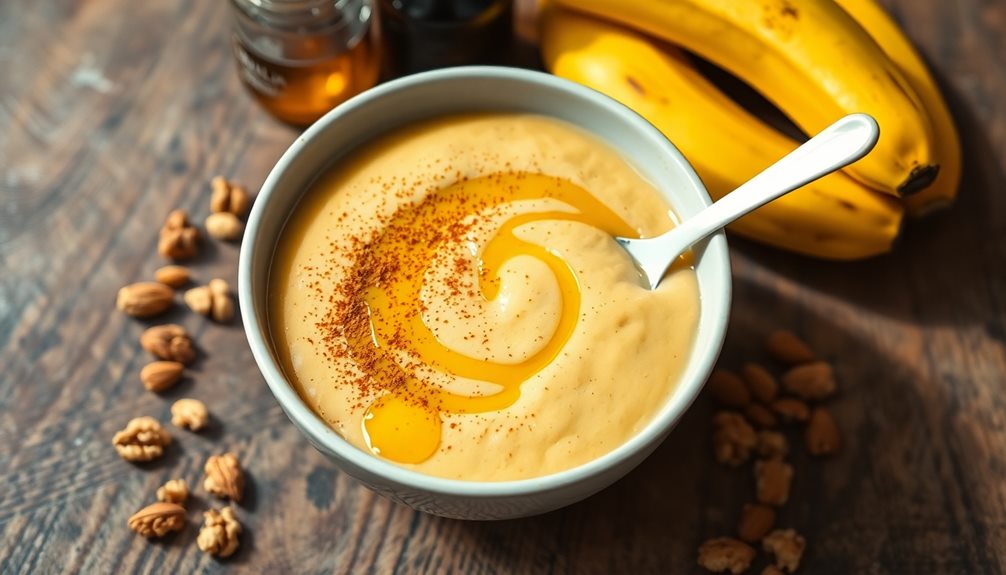To guarantee your cassava fufu is safe to eat, monitor the pH during fermentation; it should drop from around 6.5 to below 4.5 within the first 48 hours as lactic acid bacteria produce acidity. This pH level indicates the food is safe, flavorful, and less likely to spoil. Usually, after about 3 to 4 days, the pH reaches 3.5 to 4.0, confirming ideal fermentation. Keep an eye on pH trends to certify safety and quality—more details await if you continue.
Key Takeaways
- Fermented cassava fufu’s pH drops from around 6.0-6.5 to 4.5-5.0 within 24-48 hours, indicating active fermentation.
- The ideal safe consumption pH range is approximately 4.0 to 4.5, achieved after 2-3 days of fermentation.
- Monitoring pH levels ensures the fermentation is progressing safely and prevents spoilage or over-fermentation.
- Proper temperature control (around 30°C/86°F) accelerates bacterial activity and pH decline to safe levels.
- Over-fermentation (pH below 3.0) can affect texture and flavor, so timely pH checks are essential for safety.

Fermentation is a vital step in preparing cassava fufu, and understanding its timeline helps guarantee the best quality and flavor. When you start fermenting cassava, you’re engaging a natural process driven by fermentation bacteria that break down the raw starches and sugars. These bacteria, including lactic acid bacteria, play an essential role in transforming the cassava into a safe, digestible, and flavorful food. As fermentation progresses, you’ll notice pH changes—initially, the mixture has a neutral pH around 6.0 to 6.5. Over time, these bacteria produce lactic acid, which causes the pH to drop, making the environment more acidic. This acidity is a good indicator that fermentation is happening and that the cassava is moving toward a safe, sour taste.
In the early stages, within the first 24 to 48 hours, the pH begins to decline gradually. During this period, the fermentation bacteria are actively multiplying, consuming sugars and releasing lactic acid. You’ll notice a slight sour smell developing, signaling that the process is underway. The pH might drop to around 4.5 to 5.0, which is generally safe and desirable. This phase is vital because it guarantees that any harmful pathogens are suppressed by the increasing acidity. If you’re monitoring pH levels, you’ll see a steady decrease, indicating the fermentation bacteria are doing their job effectively. This period usually lasts about two days, but environmental factors like temperature can influence the speed. The temperature during fermentation can significantly affect the rate of bacterial activity and acidity development. Maintaining a proper fermentation temperature is crucial for consistent results.
As fermentation continues into days 3 and 4, the pH can decrease further, reaching about 3.5 to 4.0. At this point, the cassava has developed a tangy aroma, and the flavor becomes distinctly sour. The acidity serves as a natural preservative, extending the shelf life of your fufu and guaranteeing it’s safe for consumption. It’s essential to taste and smell the mixture during this stage to confirm that it has reached the desired acidity and flavor profile. If the pH drops too low, below about 3.0, it might indicate over-fermentation, which can affect texture and taste. Monitoring pH levels is crucial for ensuring optimal fermentation and safety. Proper fermentation control helps prevent spoilage and ensures a high-quality final product.
Frequently Asked Questions
How Does Fermentation Affect Cassava’s Nutritional Content?
When you ferment cassava, you’re engaging in a microbial transformation that enhances its nutritional content. Fermentation boosts nutrient levels like B vitamins and improves digestibility, making the food more beneficial. It also reduces anti-nutrients such as cyanogenic compounds, increasing safety. This process allows enzymes and microbes to break down complex compounds, leading to nutrient enhancement and a more nutritious, safer product for you to enjoy.
Are There Health Risks With Improperly Fermented Cassava Fufu?
When it comes to improperly fermented cassava fufu, you’re playing with fire. Toxicity concerns are real if fermentation safety isn’t upheld, leading to possible cyanide poisoning. You should guarantee proper fermentation to reduce risks, as bad practices can leave harmful levels of cyanogenic compounds. Always stick to recommended fermentation times and pH guidelines, so you don’t end up in hot water with your health.
Can Fermentation Eliminate All Anti-Nutrients in Cassava?
You might wonder if fermentation can remove all cassava toxicity, but it doesn’t eliminate every anti-nutrient. Fermentation enzymes help reduce harmful compounds like cyanogenic glycosides, decreasing cassava toxicity. However, some anti-nutrients may still remain if fermentation isn’t thorough. Proper fermentation is essential for safety, but it’s not a guarantee that all anti-nutrients are gone. You should always follow safe processing practices for cassava.
What Are Signs of Spoilage During Fermentation?
During fermentation, you should watch for signs of spoilage like visual changes—mold or discoloration—and off odors, which indicate the process has gone bad. If you notice any fuzzy growth, sliminess, or a strong sour smell beyond normal fermentation, it’s best to discard it. These signs help you determine if the cassava fufu is still safe to consume or if it has spoiled and should be avoided.
How Does Fermentation Vary Across Different Cassava Varieties?
Ever wonder how fermentation varies across cassava varieties? You’ll find that different cassava traits influence fermentation techniques and outcomes. Some varieties ferment faster due to higher sugar content, while others require longer or specific conditions. Traits like starch composition and moisture levels affect flavor and safety. By understanding these differences, you can optimize fermentation processes for each cassava type, ensuring a safe and delicious final product tailored to each variety’s unique characteristics.
Conclusion
So, as you watch your cassava fufu ferment over time, trust the science—pH levels truly guide you to safe, delicious fufu. While some say longer fermentation boosts flavor, remember that the pH drop signals it’s ready to enjoy. Don’t rush the process; patience guarantees safety and better taste. Ultimately, following the pH timeline isn’t just science—it’s your secret to perfect, safe fufu every time.









